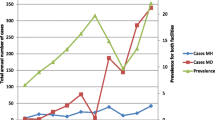Abstract
To measure the seroprevalence of high-exposure populations in brucellosis endemic areas and report the outcome and duration of seropositive asymptomatic subjects, we screened 595 family members of shepherds in Jilin Province, China and then followed up 15 seropositive asymptomatic subjects for 18 months. We found that the seropositive rate of 15.5%. Nearly half of seropositive asymptomatic subjects (7/15) developed into brucellosis in the short term; others were still seropositive asymptomatic or had decreased SAT titer in a longer time.
Similar content being viewed by others
References
Franco MP, Mulder M, Gilman RH et al (2007) Human brucellosis. Lancet Infect Dis 7(12):775–786. https://doi.org/10.1016/s1473-3099(07)70286-4
Abramson O, Rosenvasser Z, Block C et al (1991) Detection and treatment of brucellosis by screening a population at risk. Pediatr Infect Dis J 10(6):434–438. https://doi.org/10.1097/00006454-199106000-00003
Gao R, Xu Y (2008) Serological surveillance of brucellosis high exposure population in Yanqing County of Beijing in 2006. Chin J Endemiol 27(3):305–307. https://doi.org/10.3760/cma.j.issn.1000-4955.2008.03.020
Announcement on the Handling of the Brucella Antibody Positive Incident of Lanzhou Veterinary Research Institute. http://wjw.lanzhou.gov.cn/art/2020/9/15/art_4531_928158.html. Accessed 14 Nov 2020
Gheita TA, Sayed S, Azkalany GS et al (2015) Subclinical sacroiliitis in brucellosis. Clinical presentation and MRI findings. Z Rheumatol 74(3):240–245. https://doi.org/10.1007/s00393-014-1465-1
Mesner O, Riesenberg K, Biliar N et al (2007) The many faces of human-to-human transmission of brucellosis: congenital infection and outbreak of nosocomial disease related to an unrecognized clinical case. Clin Infect Dis 45(12):e135–e140. https://doi.org/10.1086/523726
Yang H, Zhang S, Wang T et al (2020) Epidemiological characteristics and spatiotemporal trend analysis of human brucellosis in China, 1950–2018. Int J Environ Res Public Health 17(7). https://doi.org/10.3390/ijerph17072382
Ran X, Chen X, Wang M et al (2018) Brucellosis seroprevalence in ovine and caprine flocks in China during 2000-2018: a systematic review and meta-analysis. BMC Vet Res 14(1):393. https://doi.org/10.1186/s12917-018-1715-6
Mantecón MA, Gutiérrez P, del Pilar ZM et al (2006) Utility of an immunocapture-agglutination test and an enzyme-linked immunosorbent assay test against cytosolic proteins from Brucella melitensis B115 in the diagnosis and follow-up of human acute brucellosis. Diagn Microbiol Infect Dis 55(1):27–35. https://doi.org/10.1016/j.diagmicrobio.2005.11.003
Diagnostic criteria for Brucellosis (2007). http://hbba.sacinfo.org.cn/stdDetail/c4434c8562c9fdc9ac1eb137425b0d26
Alsubaie S, Almuneef M, Alshaalan M et al (2005) Acute brucellosis in Saudi families: relationship between brucella serology and clinical symptoms. Int J Infect Dis 9(4):218–224. https://doi.org/10.1016/j.ijid.2004.07.009
Deniz S, Baykam N, Celikbas A et al (2015) Screening household members of acute brucellosis cases in endemic areas and risk factors for brucellosis. Vector Borne Zoonotic Dis (Larchmont, NY) 15(8):468–472. https://doi.org/10.1089/vbz.2014.1723
Tabak F, Hakko E, Mete B et al (2008) Is family screening necessary in brucellosis. Infection 36(6):575–577. https://doi.org/10.1007/s15010-008-7022-6
Calfee MW, Wendling M (2012) The effects of environmental conditions on persistence and inactivation of Brucella suis on building material surfaces. Lett Appl Microbiol 54(6):504–510. https://doi.org/10.1111/j.1472-765X.2012.03237.x
Funding
This study was supported by Health Technology Innovation Project of Jilin Province, China (Project Number: 2016J076) and Graduate Innovation Fund of Jilin University (101832020CX269). The funding agencies had no role in database design, analysis, or writing the manuscript
Author information
Authors and Affiliations
Corresponding author
Additional information
Publisher’s note
Springer Nature remains neutral with regard to jurisdictional claims in published maps and institutional affiliations.
Supplementary Information
ESM 1
(DOC 36 kb)
Rights and permissions
About this article
Cite this article
Hu, J., Zhang, X., Yang, H. et al. Brucellosis screening and follow-up of seropositive asymptomatic subjects among household members of shepherds in China. Eur J Clin Microbiol Infect Dis 40, 1325–1328 (2021). https://doi.org/10.1007/s10096-020-04115-z
Received:
Accepted:
Published:
Issue Date:
DOI: https://doi.org/10.1007/s10096-020-04115-z




